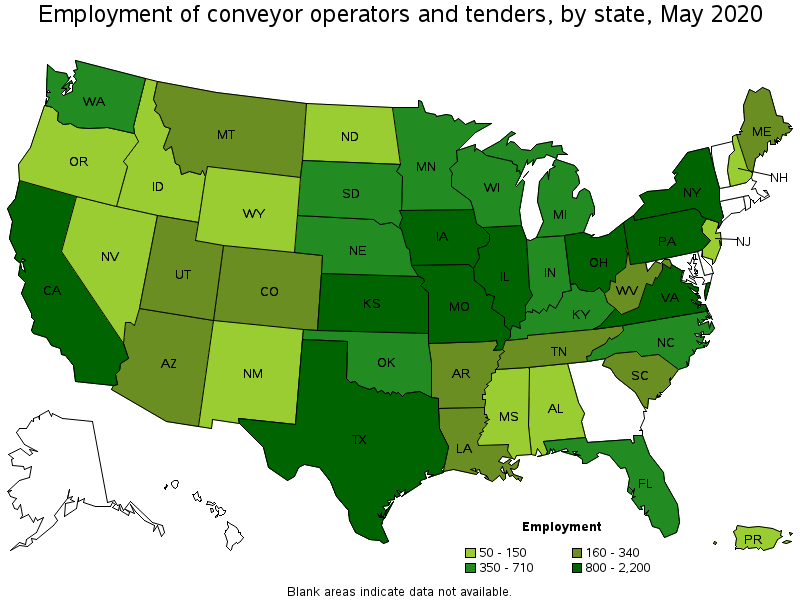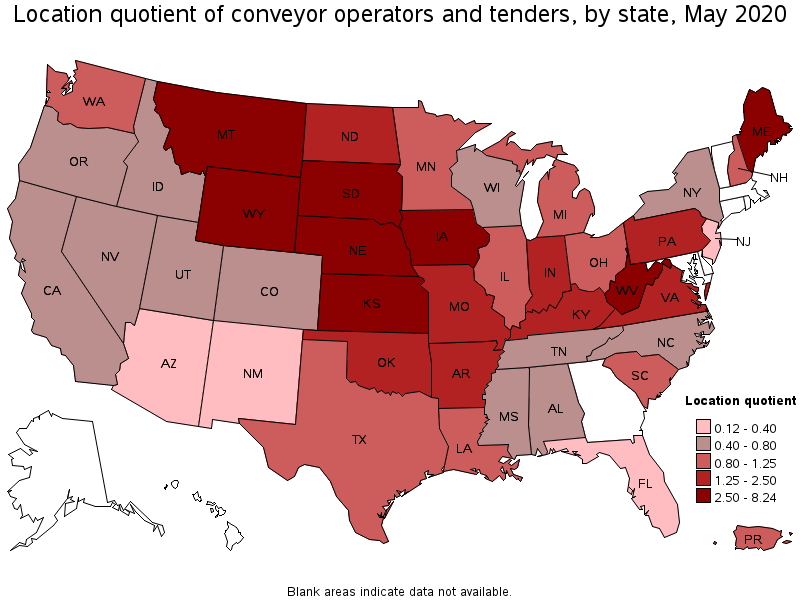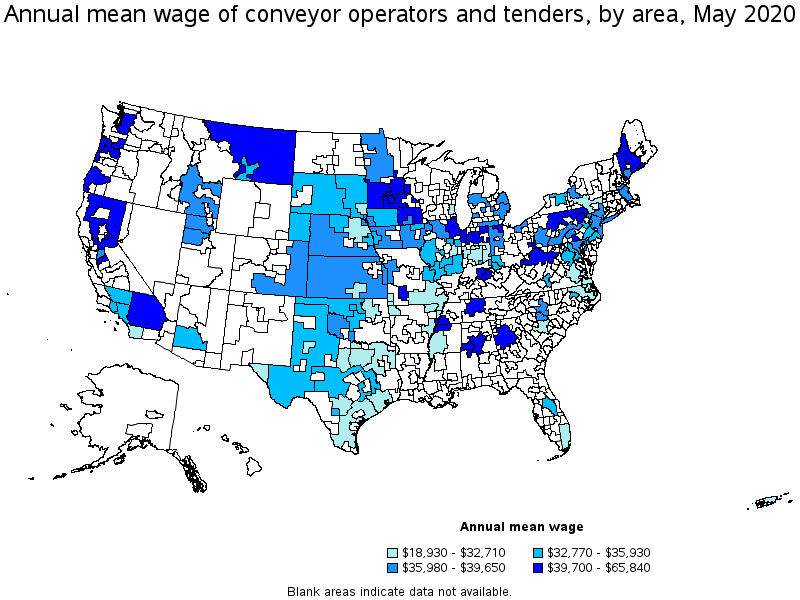An official website of the United States government
 United States Department of Labor
United States Department of Labor
Control or tend conveyors or conveyor systems that move materials or products to and from stockpiles, processing stations, departments, or vehicles. May control speed and routing of materials or products.
Employment estimate and mean wage estimates for Conveyor Operators and Tenders:
| Employment (1) | Employment RSE (3) |
Mean hourly wage |
Mean annual wage (2) |
Wage RSE (3) |
|---|---|---|---|---|
| 23,160 | 4.1 % | $ 18.05 | $ 37,540 | 1.0 % |
Percentile wage estimates for Conveyor Operators and Tenders:
| Percentile | 10% | 25% | 50% (Median) |
75% | 90% |
|---|---|---|---|---|---|
| Hourly Wage | $ 12.41 | $ 14.25 | $ 17.20 | $ 20.78 | $ 25.02 |
| Annual Wage (2) | $ 25,810 | $ 29,640 | $ 35,770 | $ 43,230 | $ 52,040 |
Industries with the highest published employment and wages for Conveyor Operators and Tenders are provided. For a list of all industries with employment in Conveyor Operators and Tenders, see the Create Customized Tables function.
Industries with the highest levels of employment in Conveyor Operators and Tenders:
| Industry | Employment (1) | Percent of industry employment | Hourly mean wage | Annual mean wage (2) |
|---|---|---|---|---|
| Couriers and Express Delivery Services | 5,020 | 0.65 | $ 16.70 | $ 34,730 |
| Farm Product Raw Material Merchant Wholesalers | 4,070 | 5.92 | $ 17.21 | $ 35,800 |
| Warehousing and Storage | 1,210 | 0.09 | $ 16.79 | $ 34,920 |
| Grain and Oilseed Milling | 1,040 | 1.68 | $ 18.67 | $ 38,840 |
| Merchant Wholesalers, Durable Goods (4232, 4233, 4235, 4236, 4237, and 4239 only) | 780 | 0.06 | $ 18.71 | $ 38,920 |
Industries with the highest concentration of employment in Conveyor Operators and Tenders:
| Industry | Employment (1) | Percent of industry employment | Hourly mean wage | Annual mean wage (2) |
|---|---|---|---|---|
| Farm Product Raw Material Merchant Wholesalers | 4,070 | 5.92 | $ 17.21 | $ 35,800 |
| Grain and Oilseed Milling | 1,040 | 1.68 | $ 18.67 | $ 38,840 |
| Coal Mining | 590 | 1.36 | $ 27.67 | $ 57,560 |
| Household Appliance Manufacturing | 730 | 1.21 | $ 23.34 | $ 48,540 |
| Animal Food Manufacturing | 420 | 0.65 | $ 17.77 | $ 36,970 |
Top paying industries for Conveyor Operators and Tenders:
| Industry | Employment (1) | Percent of industry employment | Hourly mean wage | Annual mean wage (2) |
|---|---|---|---|---|
| Truck Transportation | (8) | (8) | $ 39.95 | $ 83,110 |
| Federal Executive Branch (OEWS Designation) | 40 | (7) | $ 31.89 | $ 66,330 |
| Coal Mining | 590 | 1.36 | $ 27.67 | $ 57,560 |
| Nonmetallic Mineral Mining and Quarrying | (8) | (8) | $ 24.95 | $ 51,900 |
| Electric Power Generation, Transmission and Distribution | 50 | 0.01 | $ 24.67 | $ 51,310 |
States and areas with the highest published employment, location quotients, and wages for Conveyor Operators and Tenders are provided. For a list of all areas with employment in Conveyor Operators and Tenders, see the Create Customized Tables function.

States with the highest employment level in Conveyor Operators and Tenders:
| State | Employment (1) | Employment per thousand jobs | Location quotient (9) | Hourly mean wage | Annual mean wage (2) |
|---|---|---|---|---|---|
| Texas | 2,200 | 0.18 | 1.09 | $ 14.38 | $ 29,920 |
| California | 1,880 | 0.11 | 0.69 | $ 19.28 | $ 40,100 |
| Pennsylvania | 1,600 | 0.29 | 1.74 | $ 18.22 | $ 37,900 |
| Kansas | 1,090 | 0.82 | 4.93 | $ 17.92 | $ 37,270 |
| Illinois | 1,050 | 0.19 | 1.12 | $ 18.97 | $ 39,450 |

States with the highest concentration of jobs and location quotients in Conveyor Operators and Tenders:
| State | Employment (1) | Employment per thousand jobs | Location quotient (9) | Hourly mean wage | Annual mean wage (2) |
|---|---|---|---|---|---|
| South Dakota | 560 | 1.37 | 8.24 | $ 15.97 | $ 33,210 |
| Kansas | 1,090 | 0.82 | 4.93 | $ 17.92 | $ 37,270 |
| Iowa | 950 | 0.64 | 3.87 | $ 18.17 | $ 37,790 |
| Wyoming | 150 | 0.59 | 3.55 | (8) | (8) |
| West Virginia | 320 | 0.49 | 2.97 | $ 27.67 | $ 57,560 |

Top paying states for Conveyor Operators and Tenders:
| State | Employment (1) | Employment per thousand jobs | Location quotient (9) | Hourly mean wage | Annual mean wage (2) |
|---|---|---|---|---|---|
| West Virginia | 320 | 0.49 | 2.97 | $ 27.67 | $ 57,560 |
| Kentucky | 710 | 0.40 | 2.40 | $ 23.53 | $ 48,930 |
| New Mexico | 50 | 0.06 | 0.36 | $ 21.16 | $ 44,010 |
| Tennessee | 320 | 0.11 | 0.65 | $ 21.01 | $ 43,710 |
| Maine | 250 | 0.44 | 2.64 | $ 21.00 | $ 43,670 |

Metropolitan areas with the highest employment level in Conveyor Operators and Tenders:
| Metropolitan area | Employment (1) | Employment per thousand jobs | Location quotient (9) | Hourly mean wage | Annual mean wage (2) |
|---|---|---|---|---|---|
| St. Louis, MO-IL | 780 | 0.60 | 3.61 | $ 16.01 | $ 33,290 |
| Los Angeles-Long Beach-Anaheim, CA | 530 | 0.09 | 0.55 | $ 17.16 | $ 35,700 |
| Dallas-Fort Worth-Arlington, TX | 490 | 0.14 | 0.82 | $ 15.71 | $ 32,680 |
| Seattle-Tacoma-Bellevue, WA | 450 | 0.23 | 1.37 | $ 19.88 | $ 41,340 |
| Chicago-Naperville-Elgin, IL-IN-WI | 330 | 0.08 | 0.46 | $ 20.43 | $ 42,500 |
| Pittsburgh, PA | 300 | 0.28 | 1.70 | $ 17.54 | $ 36,490 |
| Miami-Fort Lauderdale-West Palm Beach, FL | 280 | 0.11 | 0.66 | $ 15.61 | $ 32,470 |
| Washington-Arlington-Alexandria, DC-VA-MD-WV | 250 | 0.08 | 0.50 | $ 16.25 | $ 33,810 |
| Indianapolis-Carmel-Anderson, IN | 250 | 0.24 | 1.47 | $ 15.09 | $ 31,380 |
| Riverside-San Bernardino-Ontario, CA | 240 | 0.16 | 0.96 | $ 19.31 | $ 40,170 |

Metropolitan areas with the highest concentration of jobs and location quotients in Conveyor Operators and Tenders:
| Metropolitan area | Employment (1) | Employment per thousand jobs | Location quotient (9) | Hourly mean wage | Annual mean wage (2) |
|---|---|---|---|---|---|
| Enid, OK | 40 | 1.95 | 11.69 | $ 15.76 | $ 32,770 |
| Wheeling, WV-OH | 90 | 1.54 | 9.24 | $ 31.65 | $ 65,840 |
| Lubbock, TX | 170 | 1.18 | 7.10 | $ 11.27 | $ 23,450 |
| Sioux Falls, SD | 150 | 0.97 | 5.85 | $ 14.96 | $ 31,130 |
| Rocky Mount, NC | 50 | 0.95 | 5.73 | $ 16.58 | $ 34,480 |
| Portland-South Portland, ME | 140 | 0.71 | 4.23 | $ 18.30 | $ 38,050 |
| Mankato-North Mankato, MN | 30 | 0.68 | 4.07 | $ 21.39 | $ 44,490 |
| Stockton-Lodi, CA | 150 | 0.61 | 3.67 | $ 18.29 | $ 38,050 |
| Joplin, MO | 50 | 0.61 | 3.67 | $ 15.11 | $ 31,440 |
| St. Louis, MO-IL | 780 | 0.60 | 3.61 | $ 16.01 | $ 33,290 |

Top paying metropolitan areas for Conveyor Operators and Tenders:
| Metropolitan area | Employment (1) | Employment per thousand jobs | Location quotient (9) | Hourly mean wage | Annual mean wage (2) |
|---|---|---|---|---|---|
| Wheeling, WV-OH | 90 | 1.54 | 9.24 | $ 31.65 | $ 65,840 |
| Louisville/Jefferson County, KY-IN | (8) | (8) | (8) | $ 23.71 | $ 49,320 |
| Tuscaloosa, AL | 60 | 0.58 | 3.50 | $ 21.76 | $ 45,260 |
| Sacramento--Roseville--Arden-Arcade, CA | 50 | 0.05 | 0.29 | $ 21.70 | $ 45,140 |
| Modesto, CA | 50 | 0.29 | 1.72 | $ 21.47 | $ 44,650 |
| Mankato-North Mankato, MN | 30 | 0.68 | 4.07 | $ 21.39 | $ 44,490 |
| Birmingham-Hoover, AL | 50 | 0.10 | 0.60 | $ 21.29 | $ 44,280 |
| Toledo, OH | 70 | 0.24 | 1.44 | $ 21.13 | $ 43,950 |
| Nashville-Davidson--Murfreesboro--Franklin, TN | 30 | 0.03 | 0.19 | $ 20.82 | $ 43,300 |
| Scranton--Wilkes-Barre--Hazleton, PA | (8) | (8) | (8) | $ 20.61 | $ 42,870 |
Nonmetropolitan areas with the highest employment in Conveyor Operators and Tenders:
| Nonmetropolitan area | Employment (1) | Employment per thousand jobs | Location quotient (9) | Hourly mean wage | Annual mean wage (2) |
|---|---|---|---|---|---|
| Kansas nonmetropolitan area | 830 | 2.20 | 13.21 | $ 18.41 | $ 38,290 |
| East South Dakota nonmetropolitan area | 270 | 2.10 | 12.62 | $ 16.39 | $ 34,090 |
| Southeast Iowa nonmetropolitan area | 240 | 1.13 | 6.81 | $ 18.16 | $ 37,780 |
| Central East New York nonmetropolitan area | 230 | 1.51 | 9.05 | $ 13.74 | $ 28,580 |
| Southern Pennsylvania nonmetropolitan area | 200 | 1.13 | 6.76 | $ 18.82 | $ 39,150 |
Nonmetropolitan areas with the highest concentration of jobs and location quotients in Conveyor Operators and Tenders:
| Nonmetropolitan area | Employment (1) | Employment per thousand jobs | Location quotient (9) | Hourly mean wage | Annual mean wage (2) |
|---|---|---|---|---|---|
| East Arkansas nonmetropolitan area | 180 | 2.65 | 15.95 | $ 14.49 | $ 30,130 |
| Kansas nonmetropolitan area | 830 | 2.20 | 13.21 | $ 18.41 | $ 38,290 |
| West South Dakota nonmetropolitan area | 130 | 2.16 | 12.98 | $ 16.05 | $ 33,380 |
| Eastern and Southern Colorado nonmetropolitan area | 140 | 2.12 | 12.71 | $ 17.43 | $ 36,240 |
| East South Dakota nonmetropolitan area | 270 | 2.10 | 12.62 | $ 16.39 | $ 34,090 |
Top paying nonmetropolitan areas for Conveyor Operators and Tenders:
| Nonmetropolitan area | Employment (1) | Employment per thousand jobs | Location quotient (9) | Hourly mean wage | Annual mean wage (2) |
|---|---|---|---|---|---|
| Northern West Virginia nonmetropolitan area | 50 | 0.40 | 2.40 | $ 28.85 | $ 60,020 |
| Southwest Maine nonmetropolitan area | 60 | 0.30 | 1.81 | $ 25.80 | $ 53,670 |
| East-Central Montana nonmetropolitan area | 120 | 1.93 | 11.59 | $ 23.61 | $ 49,110 |
| North Valley-Northern Mountains Region of California nonmetropolitan area | 30 | 0.31 | 1.88 | $ 22.55 | $ 46,900 |
| Coast Oregon nonmetropolitan area | 60 | 0.56 | 3.34 | $ 20.75 | $ 43,150 |
These estimates are calculated with data collected from employers in all industry sectors, all metropolitan and nonmetropolitan areas, and all states and the District of Columbia. The top employment and wage figures are provided above. The complete list is available in the downloadable XLS files.
The percentile wage estimate is the value of a wage below which a certain percent of workers fall. The median wage is the 50th percentile wage estimate—50 percent of workers earn less than the median and 50 percent of workers earn more than the median. More about percentile wages.
(1) Estimates for detailed occupations do not sum to the totals because the totals include occupations not shown separately. Estimates do not include self-employed workers.
(2) Annual wages have been calculated by multiplying the hourly mean wage by a "year-round, full-time" hours figure of 2,080 hours; for those occupations where there is not an hourly wage published, the annual wage has been directly calculated from the reported survey data.
(3) The relative standard error (RSE) is a measure of the reliability of a survey statistic. The smaller the relative standard error, the more precise the estimate.
(7) The value is less than .005 percent of industry employment.
(8) Estimate not released.
(9) The location quotient is the ratio of the area concentration of occupational employment to the national average concentration. A location quotient greater than one indicates the occupation has a higher share of employment than average, and a location quotient less than one indicates the occupation is less prevalent in the area than average.
Other OEWS estimates and related information:
May 2020 National Occupational Employment and Wage Estimates
May 2020 State Occupational Employment and Wage Estimates
May 2020 Metropolitan and Nonmetropolitan Area Occupational Employment and Wage Estimates
May 2020 National Industry-Specific Occupational Employment and Wage Estimates
Last Modified Date: March 31, 2021